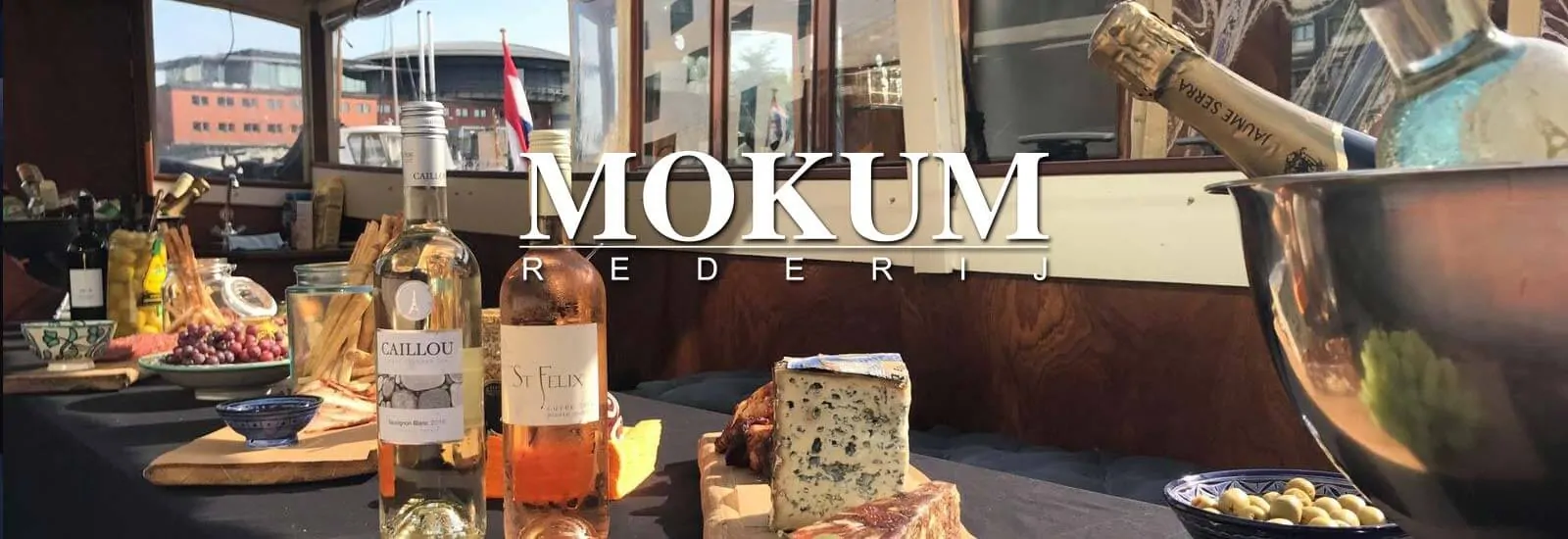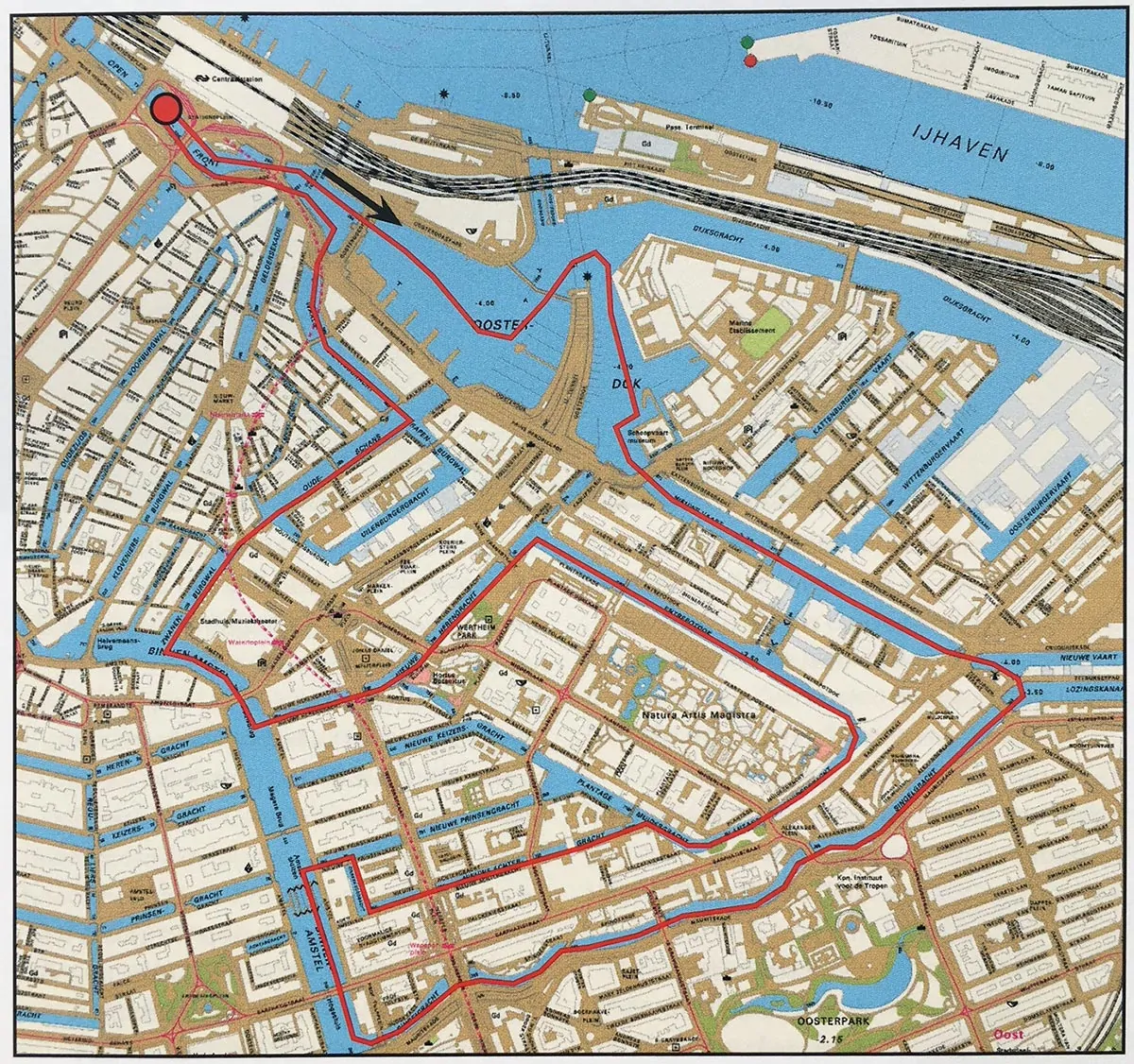
Cruise East Amsterdam

Duration: 2 hours Lowest bridge no. 252 Unknown Gracht/Nieuwe Achtergracht: 1.77 m +NAP Source: The Amsterdam sailing guideDownload this cruise Back to all cruises The Vaartocht Oost takes you to the watery east of the city. Although many authentic buildings have completely or partially disappeared, such as the Haringpakkerstoren and the Sint Antoniepoort, history comes to life from the water. Sailing over the Entrepotdok or along the Magere Brug we see the remains of historical activity. They illustrate the influence of trade and shipping on the development of Amsterdam.
We leave from Central Station towards the east, along the Prins Hendrikkade.
Until the beginning of the nineteenth century, the Prins Hendrikkade was located on the open IJ. After the Marine Dock, the Oosterdok was also constructed. Docks were created to prevent the harbor from silting up and to guarantee sufficient draft for seagoing ships. When the Central Station was built at the end of the nineteenth century and the development of the Eastern Docklands took on broader forms, the city center was definitively separated from the IJ. On the starboard side is the Schreierstoren, one of the oldest remaining defense works in Amsterdam. The Schreierstoren was part of the medieval city walls of Amsterdam. Unfortunately, due to the raising of the roads, the tower has lost part of its imposing character. The story goes that the Schreierstoren owes its name to the women who said goodbye to their departing husbands from this place, crying about an uncertain future. Less than a hundred meters further on, on the starboard side, on the corner of Prins Hendrikkade and Binnenkant, you will see the Scheepvaarthuis. The Shipping House was built at the beginning of the last century on behalf of six shipping companies. It is generally seen as the first building designed entirely in the style of the Amsterdam School. A large group of well-known artists contributed to the numerous decorations of the interior and exterior. These decorations refer in many ways to the rich shipping tradition of the Netherlands. The building is located on the place where Cornelis Houtman, a future legend, started the first journey to the East Indies. After the last shipping company left the building in 1981, the Shipping House was occupied by the Municipal Transport Company in August 1983. After a major renovation, the shipping house has been home to the luxurious 5-star Grand Hotel Amrâth since 2007. We are now sailing under bridge no. 294. On the port side we see a remarkable building. The nice catering business Hannekes Boom is located here. Hanneke was built entirely according to the cradle to cradle principle. Waste does not exist but is building material. The fact that the concept has been a hit is evident from the many visitors. You can moor in front of the door. Hannekes Boom has its own harbour. 
We sail around the Nemo and move along the naval site. Nb. prohibited to moor in the direction of the Maritime Museum.
The building, dating from 1655, used to function as the country’s sea warehouse: a storage facility for the navy. The Maritime Museum is open again after years of renovation. The museum shows how the sea has determined Dutch culture. Interactive exhibitions provide insight into more than 500 years of maritime history. The replica of the Amsterdam, the unfortunate East Indiaman who sank on her first voyage to Asia in 1749, is also back in its usual place at the maritime museum. Unlike the proud Batavia, a VOC replica built in Lelystad, the Amsterdam is not suitable for sailing. Opposite the Maritime Museum, on the east side of the Kikker, is a beautiful collection of Old Dutch ships. Enthusiasts who have viewed the Amsterdam should also take a dip here.
We sail past the Maritime Museum and turn port onto the Nieuwe Vaart.
On the right we see the Maritime Training School, built at the end of the nineteenth century. Until 1971, independent education was provided in this building for training as a ship’s officer in the merchant navy. Nowadays the building mainly serves as a housing institute for students of the Amsterdam University of Applied Sciences. On the port side is the Oosterkerk. When we pass under bridge no. 277, we see one of the last remaining shipyards in this part of Amsterdam on the starboard side. ‘Werf ‘t Kromhout’ is named after a curved piece of wood that was used as a connection between the deck and the board of a ship. There was a shipyard with this name on this site as early as around 1760. In 1867 the yard was taken over by a member of the Goedkoop family, who modernized the yard and made it suitable for the construction of iron ships. The last wooden vessel was built at this yard in 1874. After several years of experimenting, J. Goedkoop succeeded in developing a petroleum engine with magnet ignition in 1904. Shortly afterwards, the construction of steam engines and boilers was permanently stopped. Part of the family would focus entirely on engine building and founded the ‘Kromhout engine factory’ in Amsterdam-Noord. The engine developed at the shipyard was perfected here and grew into a product of worldwide fame. The yard remained in operation as a repair yard for inland vessels until 1967. Demolition was just prevented thanks to recognition as a national monument. Museum ‘t Kromhout has been located at the shipyard since 1973. The shipyard has now been taken over by a new owner.
We sail past museum ‘t Kromhout, in an easterly direction.

We turn starboard out of the Amstel and sail under the Sarphati Bridge (bridge no. 246). On the Amstel we pass the Amstel locks (for closing times see the Bridge List) and sail straight towards the Magere Brug.
The Magere Brug is one of the most famous bridges in Amsterdam. This picturesque, white-painted bridge has spanned the Amstel since 1672. Some people claim that two wealthy ladies – named Mager, and both living on opposite sides of the Amstel – had the bridge built to make it easier to have tea together. Another explanation is more obvious. The bridge used to be so narrow that two people could hardly pass each other. Over time, the bridge was replaced by a wider one to allow passage for the then popular carriages.
Before the Magere Brug we turn starboard out of the Nieuwe Prinsengracht in an easterly direction. We immediately turn starboard onto a small canal called ‘Ononieme Gracht’. As we pass the back of the Royal Theater Carré, we turn to port onto the Nieuwe Achtergracht.
After passing bridge no. 260 we sail under some buildings of the University of Amsterdam. We continue to follow the Plantage Muidergracht towards starboard. We then pass bridge no. 264 and sail along the back of Artis.
We follow the waterway towards port and enter the Entrepotdok.
When we enter the Entrepotdok, we see a number of brand new buildings on the starboard side. After a number of serious squatter riots, old warehouses had to make way for efficient new construction. Fortunately, there is still an impressive row of warehouses. Some date from the early eighteenth century. In addition to warehouses, the owners’ homes were located here. At the beginning of the nineteenth century, after the decision to use this part of the city as a General State Entrepot, these made way for even more warehouses. Goods whose destination had not yet been determined were stored here under the supervision of customs. This way you did not have to pay excise duties and import duties on these goods.
At the end of the Entrepotdok we turn to port onto the Nieuwe Herengracht.

We are now sailing starboard onto the Amstel in the direction of the Center and pass the Stopera. Pass the Stopera, which serves as a town hall and theater, among other things. < strong>we go to starboard, via the Zwanenburgwal, onto the Oude Schans.
Café De Sluijswacht is located in the lock keeper’s house, which is located on the port side of the St. Anthonies lock. Docking here is not easy. To visit the café, it is best to turn left into the Snoekjesgracht. When we pass under bridge no. 289, we find a fantastic mooring place. From there it is less than a 50 meter walk to the café.
We resume our journey at De Sluijswacht and head north.
On the port side we see the Montelbaanstoren. This defense tower was built at the beginning of the seventeenth century and has narrowly escaped the demolition hammer several times. Just a few years after its construction, the tower began to lean dangerously. With the help of ropes, cables and the efforts of the citizenry, the tower was returned to its original position.
Past the Montelbaanstoren we turn left onto the Waals-Eilandsgracht.
At the end of this Waals-Eilandsgracht we sail out to port towards the place where we started: the Central Station. Download this cruise Back to all cruises
